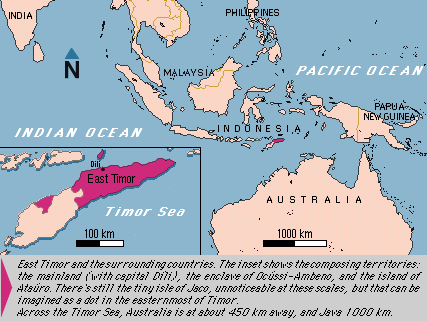Dedicated to Tilson and all the other |

provided courtesy of http://etan.org/timor/1whitepg.htm |
From the early 1600s, the Dutch and Portuguese fought over Timor. They ended up dividing it, with the Dutch controlling the western half and the Portuguese the eastern half.
When the Dutch East Indies won their independence and became the Republic of Indonesia in 1950, West Timor was incorporated into it. East Timor remained a Portuguese colony until the mid-1970s, when Portugal's overseas empire began to fall apart.
East Timor declared its independence on November 28, 1975. But it didn't stay independent for long. Unfortunately for the tiny nation's dreams of freedom, Indonesia controlled not only West Timor but virtually every other nearby island as well.
Most Americans don't realize how large Indonesia is. Close to 200 million people live on its 17,000 islands; only China, India and the US have larger populations. (The capital, Jakarta, is on the island of Java, where about three-fifths of Indonesia's population lives.)
Indonesia's army and government are among the most brutal in the world. In 1965, the army murdered more than a million alleged enemies of the government (including women and children) in a period of a few months.
The generals who run Indonesia aren't interested in self-determination, human rights or other wimpy, democratic ideals. They're interested in maintaining control over their vast territory and plundering it for as much profit as they can—almost always with the help of Western or Japanese partners.
Just nine days after East Timor declared its independence—and just two days after President Suharto of Indonesia hosted US President Gerald Ford and Secretary of State Henry Kissinger at a state dinner—Indonesia invaded East Timor. It was December 7, 1975 and—like the attack on Pearl Harbor on the same date in 1941—it's a day that will live in infamy.
In the first few weeks of the invasion, Indonesian troops killed tens of thousands of people. That wasn't surprising, given Indonesia's record. But the genocidal war of occupation Indonesia has been waging ever since has broken new ground, even for them.
In 1975, East Timor had a population of about 690,000. In the twenty years since then, more than 200,000 East Timorese have died as a result of the Indonesian occupation.
In this book, Matthew Jardine and Noam Chomsky tell the story of East Timor's heroic resistance against all odds. They also explain why you hardly ever hear about East Timor on TV or in the newspapers—and why, when the Indonesian army murders someone there, you and I pay for the bullets they use.
Arthur Naiman
back to Contents...
continue reading...
[For a hard copy of this book, try your local bookstore or call Odonian Press at 800 REAL STORY. Or visit Common Courage Press]